-
Car Reviews
- All reviews
- Midsize SUVs
- Small cars
- Utes
- Small SUVs
- Large SUVs
- Large cars
- Sports SUVs
- Sports cars
- Vans
Latest reviews
- Car News
-
Car Comparisons
Latest comparisons
- Chasing Deals
Polestar’s first model on an all-new platform shared with Chinese parent Geely brings interesting styling and quick AWD pace. But it’s not particularly fun to drive
Let’s deal with the elephant in the room first. The Polestar 4 has no rear window.
That’s not good: the featureless upper tailgate looks odd, and aft visibility is, as expected, bad – despite the fitment of a technically impressive and high-definition digital rear view mirror.
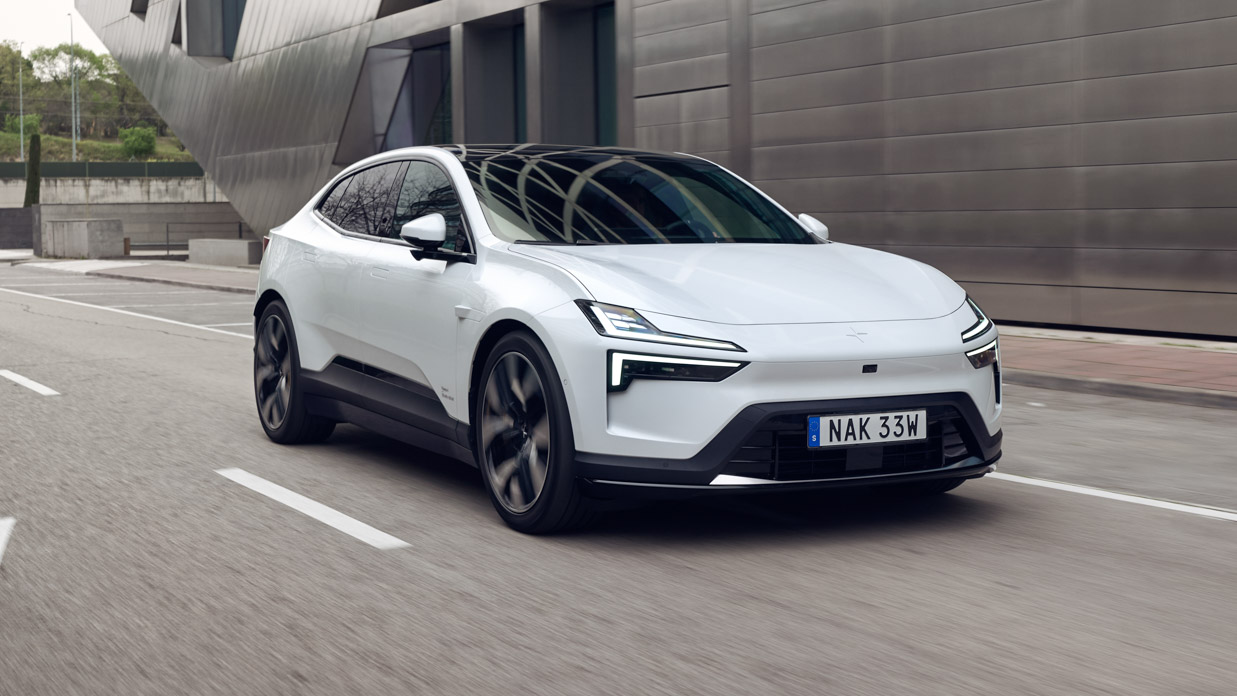
The problem is us. Human eyes haven’t evolved fast enough to be able to refocus our vision between far (looking out the windscreen) and near (a screen centimetres from our face). Digital rear view mirrors aren’t real mirrors. Our eyesight can’t shift to them rapidly.
We forgive the crutch of a rear-view camera ‘mirror’ for severely compromised vehicles like vans.
But the Polestar 4 isn’t a van: it’s a kind of raised liftback. It’s a similar shape to a BMW i4, Audi A5 Sportback or a Kia Stinger. The format isn’t bespoke enough to justify the lack of glasshouse.
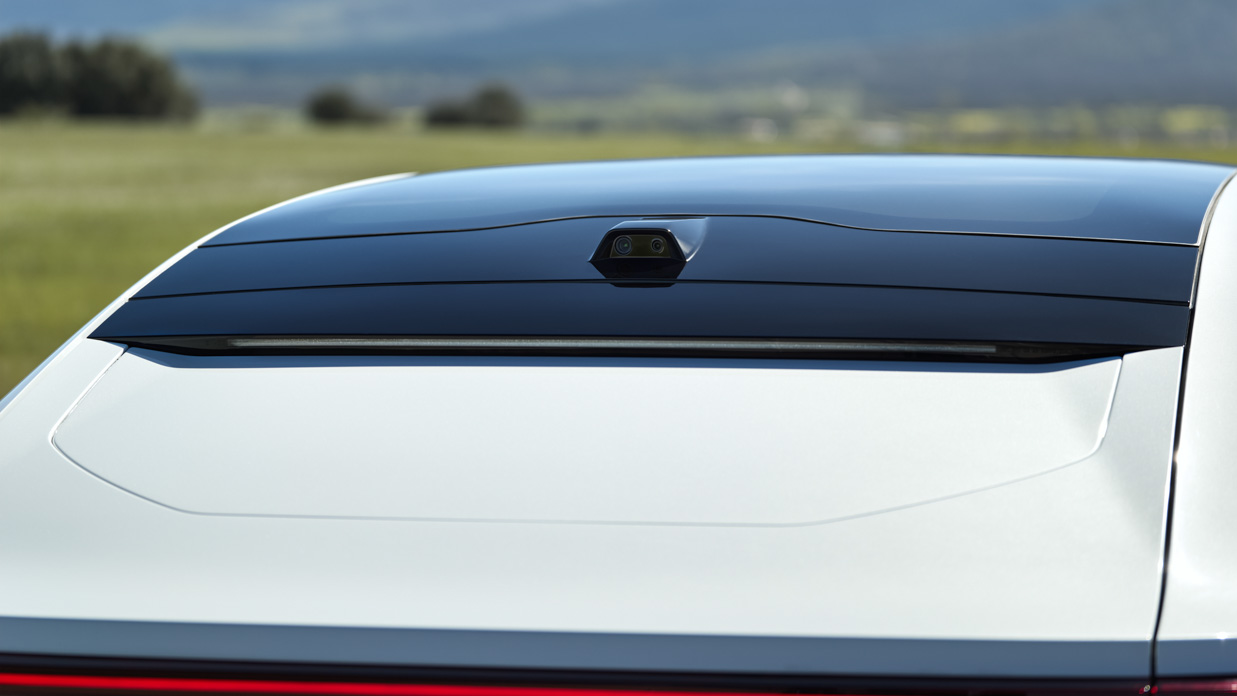
Polestar says it might take a few weeks to get used to the arrangement, but even if that’s right, buyers will be adjusting to an undesirable compromise. The rear glass screen omission feels a bit tacky – as if it was designed to grab headlines rather than make some quantum leap in usability and vehicle packaging.
That’s despite the excuse that the rear window had to be sacrificed for back-seat headroom, which is only very marginally improved over something like an i4 – let alone the Polestar 4’s (claimed) direct rival, the incoming Porsche Macan EV.
It’s a shame, because the Polestar 4’s fundamentals are otherwise decent.
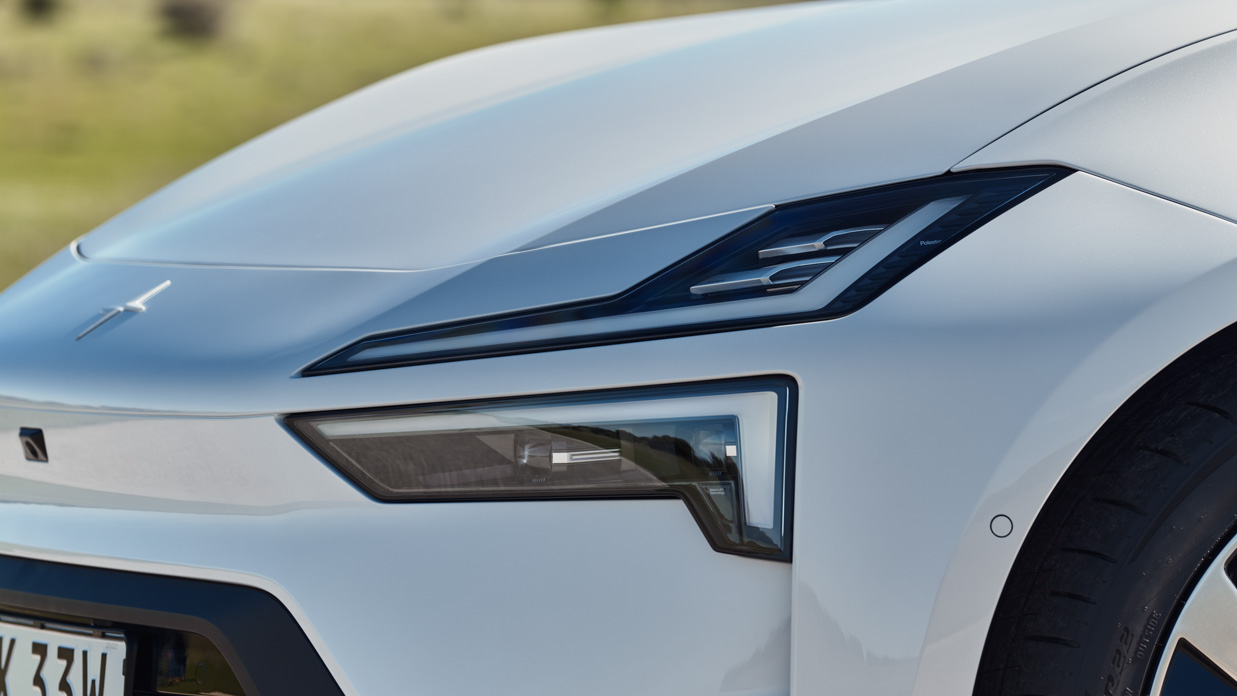
While the newcomer is part of Polestar’s unabashed push into luxury territory – the Swedish sporty EV outfit doesn’t care to be a sub-$100K, Tesla competitor anymore – there’s actually still a half-affordable, price-leading model.
Capable of capturing Australia’s federal EV incentives, an unoptioned rear-wheel drive ‘4’ gives change from $90,000 on road. It’s possible to spend much more, on variants Polestar would prefer people bought.
Our first international drive was in a dearer, circa-$120K dual-motor AWD fitted with Performance pack.
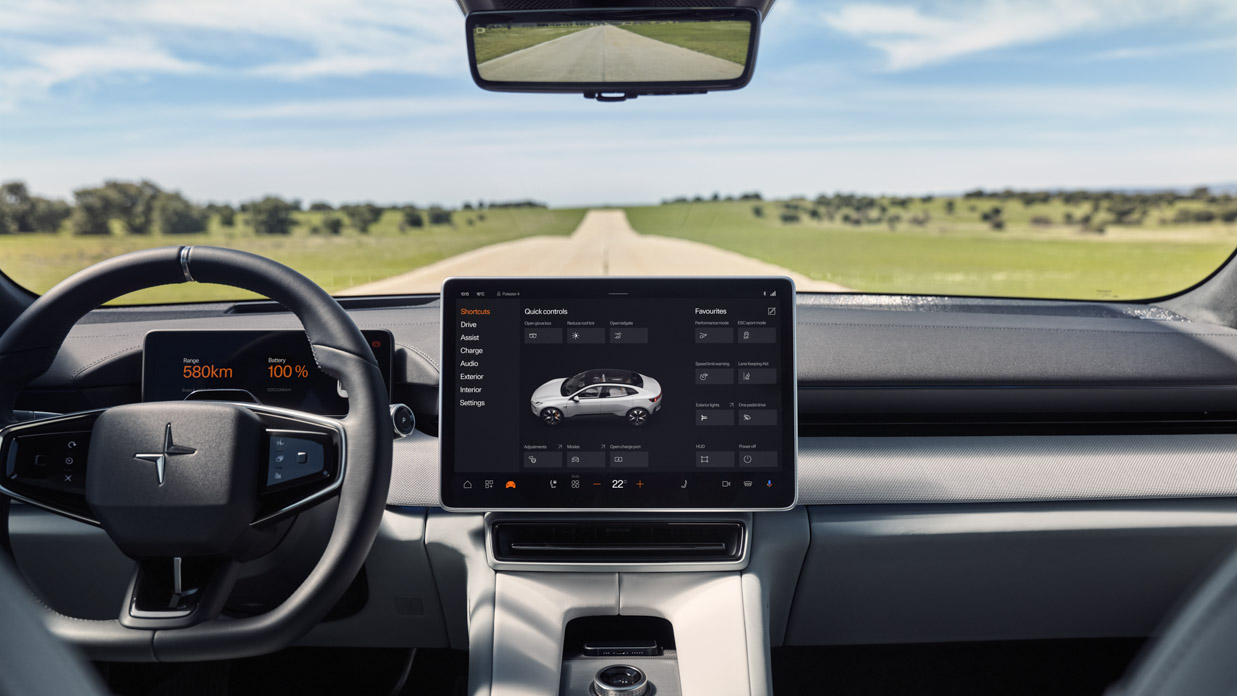
Painted in ‘Snow’ white paint over an interesting, expensive-feeling (but sustainably recycled) 3D knit textile interior, the Polestar 4 certainly feels like a premium step above the elevated-mainstream Polestar 2 sedan that has become a familiar sight on Australian roads…usually as an Uber vehicle.
Like the Polestar 3 large SUV it will launch virtually alongside, the ‘4’ is part of electric specialist Polestar’s ambitious upmarket push, with at least two additional models – the ‘5’ sports sedan and ‘6’ convertible – set to be far more expensive again, riding on superlight aluminium platforms.
Polestar executives say that the brand has grown up and moved out of Volvo’s house. The pricing – and certainly the design efforts, even if not all are successful – do underpin that messaging.
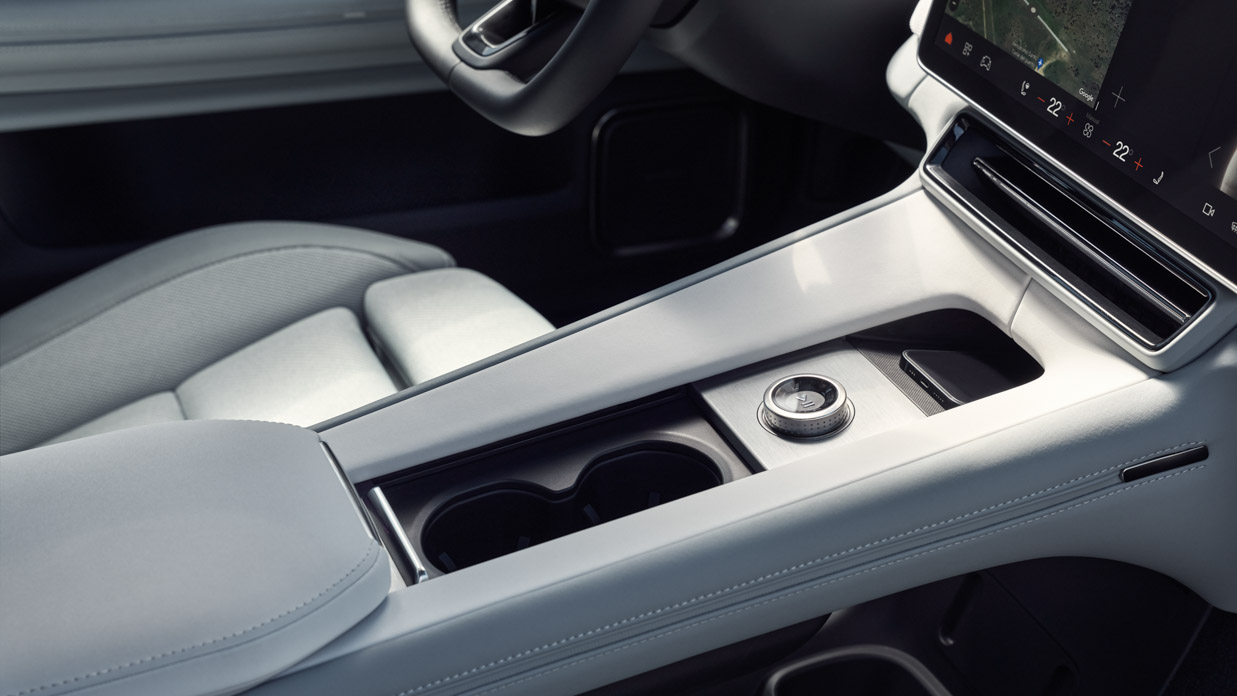
But unlike the hugely effective Polestar 3, which we published our first road test of last month, the ‘4’ is not nearly as well-resolved. It is a good car, but not a great one. Yet.
The rear window is one thing, but of greater chagrin to us is that the Polestar 4 just isn’t fun to drive. At least not in dual-motor AWD form. There is, however, hope for the single-motor, rear-wheel drive version.
While the Polestar 3 is superbly well-tuned and surprisingly rewarding behind the wheel, the handling balance of the ‘4’ feels unfinished by direct comparison. And it was a direct comparison: we drove ‘3’ and ‘4’ on successive days on the same Spanish roads at the vehicles’ global launch event.
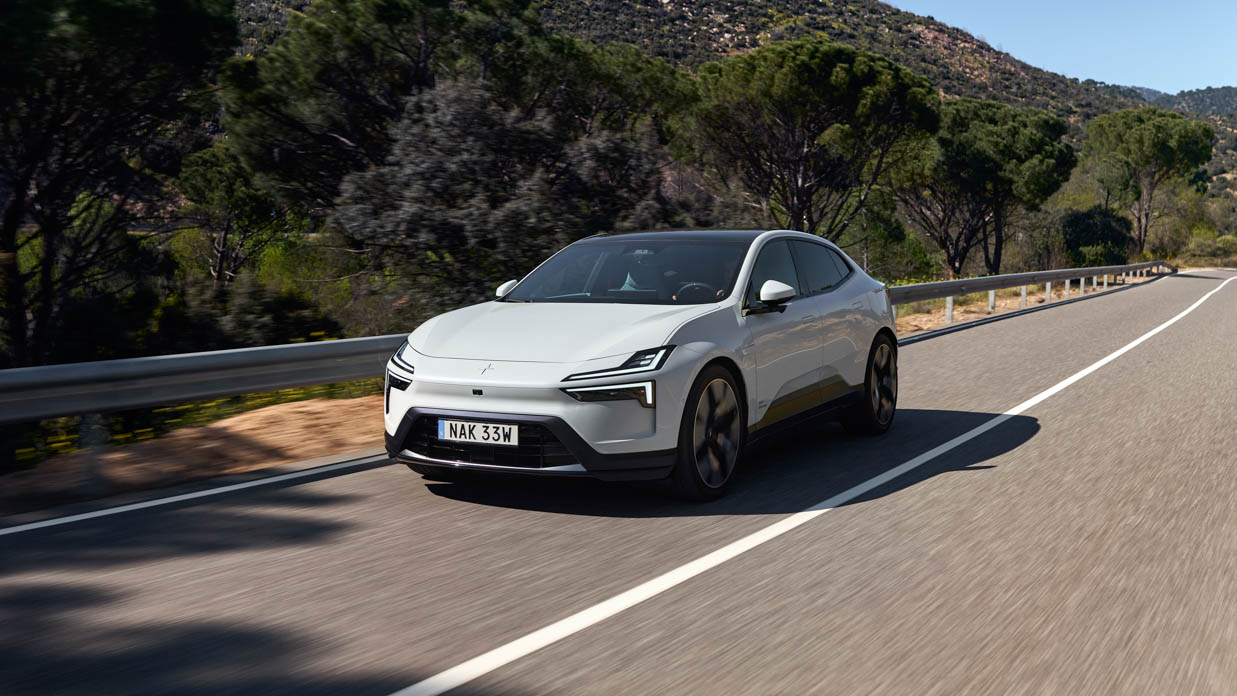
They are remarkably different cars. In some ways that is unsurprising: ‘3’ and ‘4’ are mechanically unrelated, riding on separate platforms. Some differences in feel are expected, but the two are so varied it is as if these vehicles were developed by unrelated companies. Only the ‘3’ feels fully-baked.
New platforms can create challenges for chassis engineers and it can take years to get the best from the available componentry. Maybe this explains it? The larger ‘3’ rides on a development of a years-old chassis dating back to the outgoing Volvo XC90 – that car launched a decade ago.
But frankly, at the Polestar 4’s price – and with such a confident declaration that it’s ready to take on the new Macan – we expect a lot, and the dual-motor ‘4’ doesn’t deliver on driver engagement.
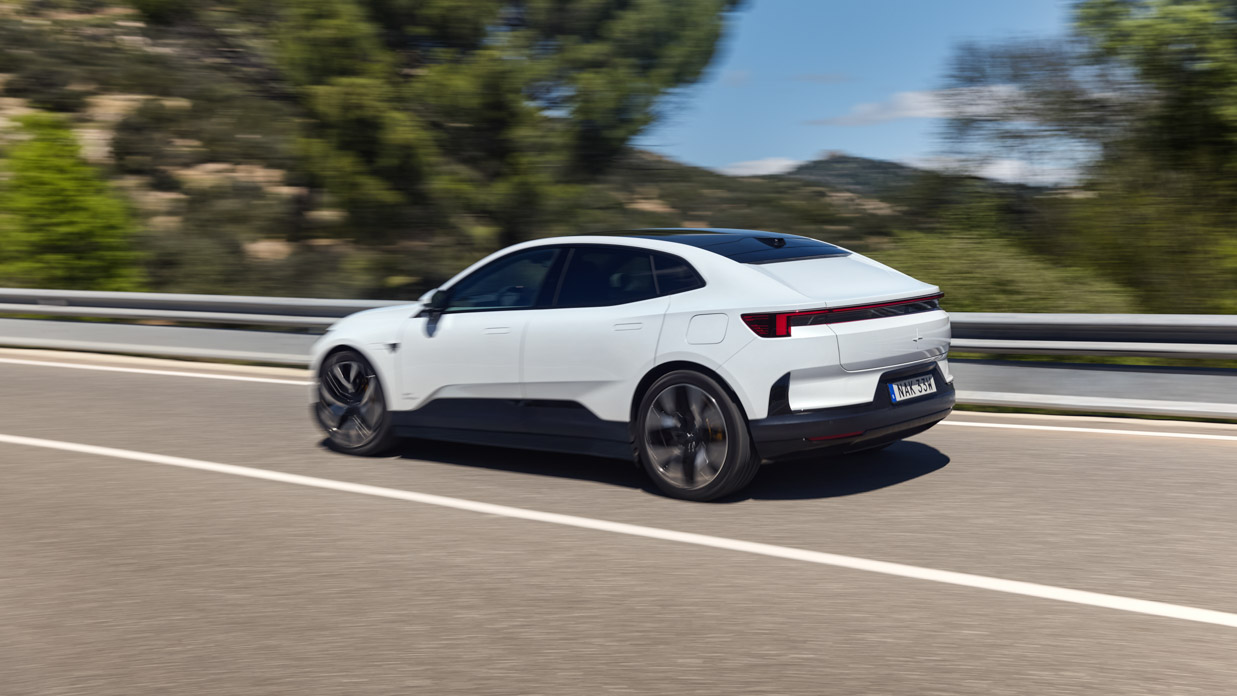
Sure, it’s fast, as nearly all AWD electric cars are. With 400kW of power coming from two 200kW motors – one per axle – 0-100km/h is dispatched in less than four seconds and it feels every bit as quick. Straight-line pace is astonishing.
But a bit like the rear window thing, straight-line speed is ultimately gimmicky, because it’s easy to achieve and ultimately a bit pointless. These days, we’re far more interested in EVs that belie their inherent weight, ride properly and are fun to punt around a set of corners.
Therein lies the problem: the ‘4’ is well-balanced, rigid and competent, but it’s as if the engineers ended up suppressing the fun gene, if it was ever there. That didn’t happen in the case of the ‘3’, which gives drivers more options and a broader stream of information from its steering and chassis.
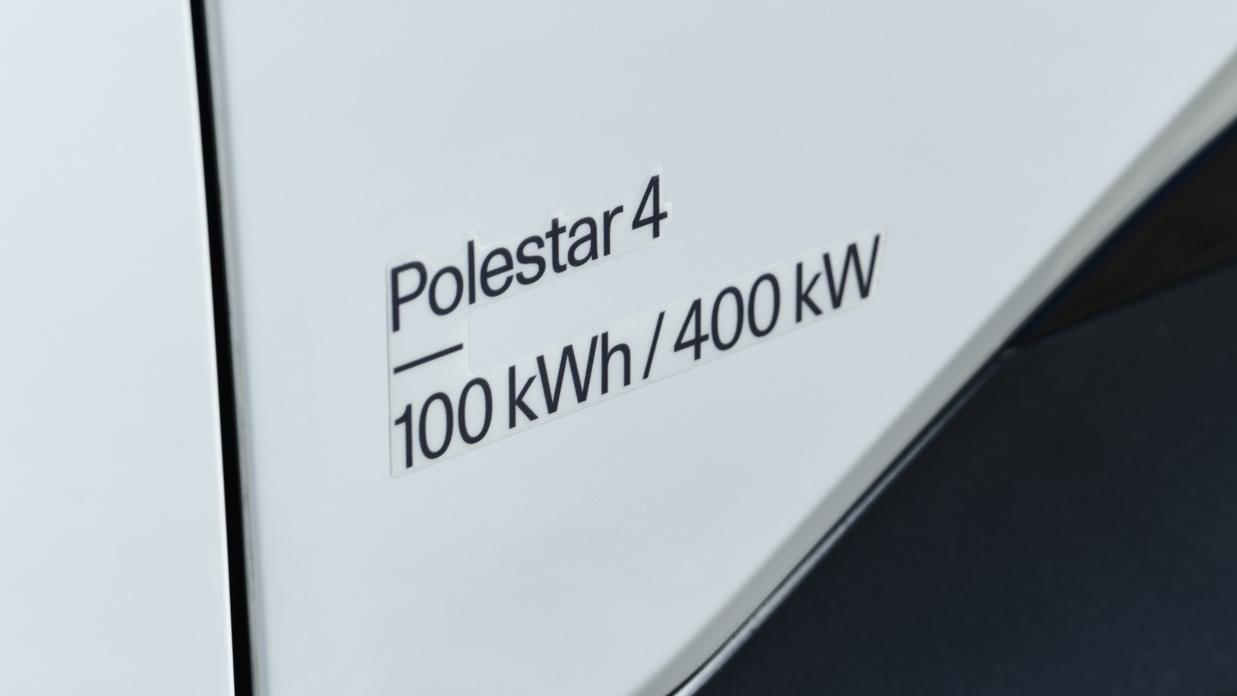
Lush, sweet steering feel in the ‘3’ is replaced by a fairly digital and lifeless rack in the ‘4’. It’s mid-weighted and easy to drive but the car gives you nothing more than plentiful tyre grip, at least. It’s fast but conservative to drive, especially in the corners where the dominant characteristic is understeer.
We initially thought the problem was that the powerful 200kW front motor matches the rear, which naturally creates handling neutrality. But the Polestar 3 also has equally balanced motor outputs. The issue is software. The Polestar 4 needs its code rejigged to drive out of corners relying more on its rear motor.
Polestar mostly had journalists drive the dual-motor AWD model with the optional Performance pack, which adds 22-inch wheels shod in Pirelli P Zero tyres, stiffer suspension and Brembos – maximum specs designed to eke out every last piece of mechanical and chemical grip. There’s too much of both!
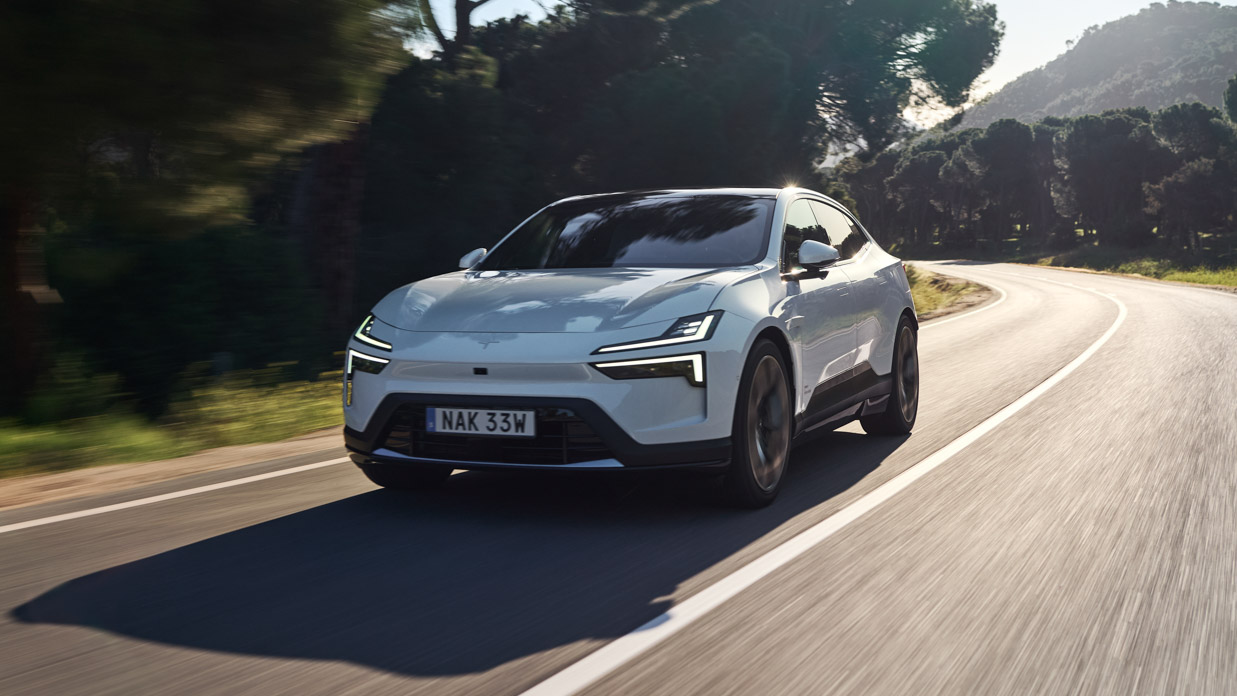
It’s no surprise that the driving suddenly became more fun when I was allowed a quick stint in a single-motor RWD ‘4’ that was hiding as a sundry vehicle at the lunch stop.
The single-motor version felt almost relieved to be stripped of the additional 100kg-plus(!) weight of the additional motor. The front axle was immediately livelier and more zealous. The steering improves. The feeling of being pushed from the rear from corners is enhanced – even if the stability control is still too conservative.
The sole RWD model on hand also happened to sport one-inch smaller wheels – the 21s that come with the Pro pack rather than the (AWD-only) Performance package – so the single-motor car would probably ride better too.
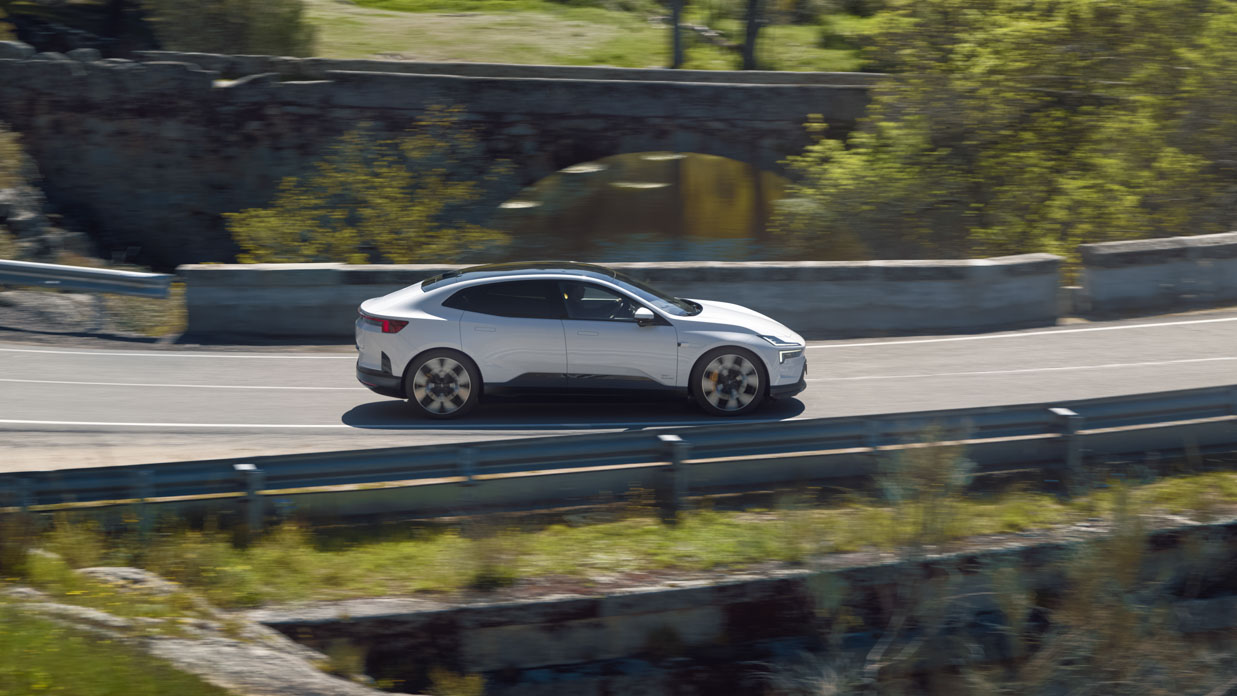
But compared to over 100km in the AWD, we were only afforded probably 10km in the RWD, so it’s too soon to rate the single-motor version properly. We’ll have to wait until the ‘4’ range reaches Australia, but we won’t be surprised in the slightest if the single-motor critically outperforms the AWD powertrain.
As for the ride? Polestar hosted the first road drive of both ‘3’ and ‘4’ near Madrid, where the road surface is frustratingly glassy and way beyond the quality of virtually any Australian surface. We aimed for the bumps and sensed a firm, taut ride, but comfort assessments must wait.
Instructively, Polestar 4 examples optioned to the hilt in AWD form with Performance package pick up adaptive dampers – controllable from within the cabin rather than manually, as in the Polestar 2 Performance – but all other variants have passive dampers.
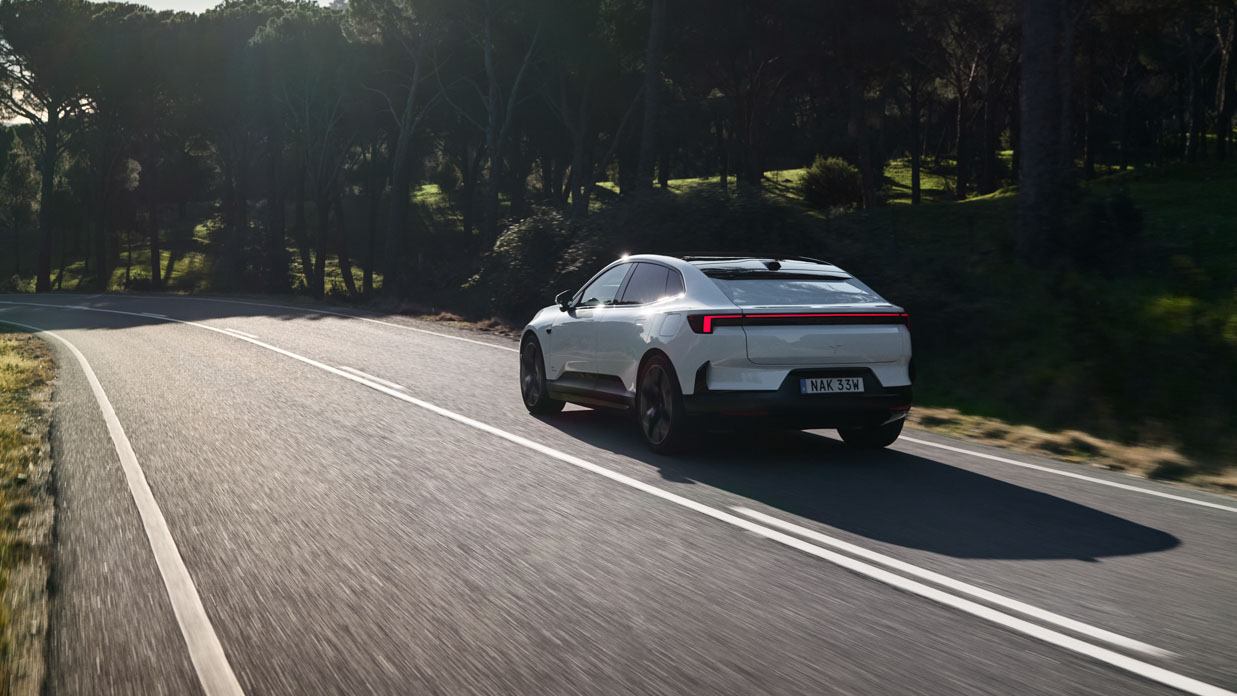
It is probably fair to expect that the ride won’t be as sophisticated as what you get in the bigger Polestar 3, which has standard-fit dual-chamber adaptive air suspension.
But that’s also a far more expensive car, kicking off from $132,720 before on-road costs, though a recently announced single-motor RWD variant is likely to be cheaper.
Really, the big strength of the Polestar 4 is its interior. Ergonomically, it’s good, with a new (for the brand) landscape-orientated touchscreen that is bright and easy to navigate thanks to big touch targets. It’s equipped with a Google-driven operating system supported by CarPlay and Android Auto.
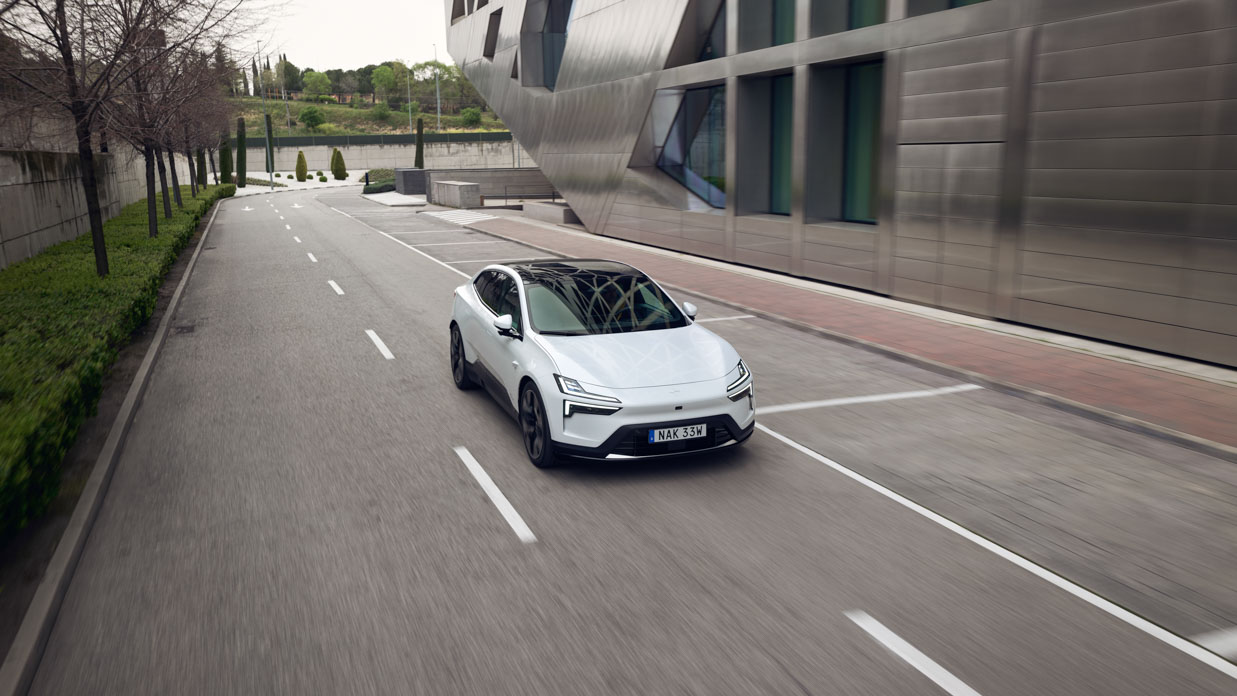
About the only misstep is fussy dashboard air vents that can only be controlled through convoluted touchscreen menus when a physical toggle is so much faster to manipulate to get air towards or away from your face.
We enjoyed the 3D knit textile upholstery of our tester, which is included in the $8000 Plus package that also bundles a worthy (if not exceptional) Harman Kardon premium stereo and upgraded headlights.
From there, buyers can option sustainably-sourced animal welfare-certified Nappa leather from Scottish supplier Bridge of Weir in either charcoal or zinc (light grey), though this is a further $7000 option. Feel-good hide doesn’t come cheap.
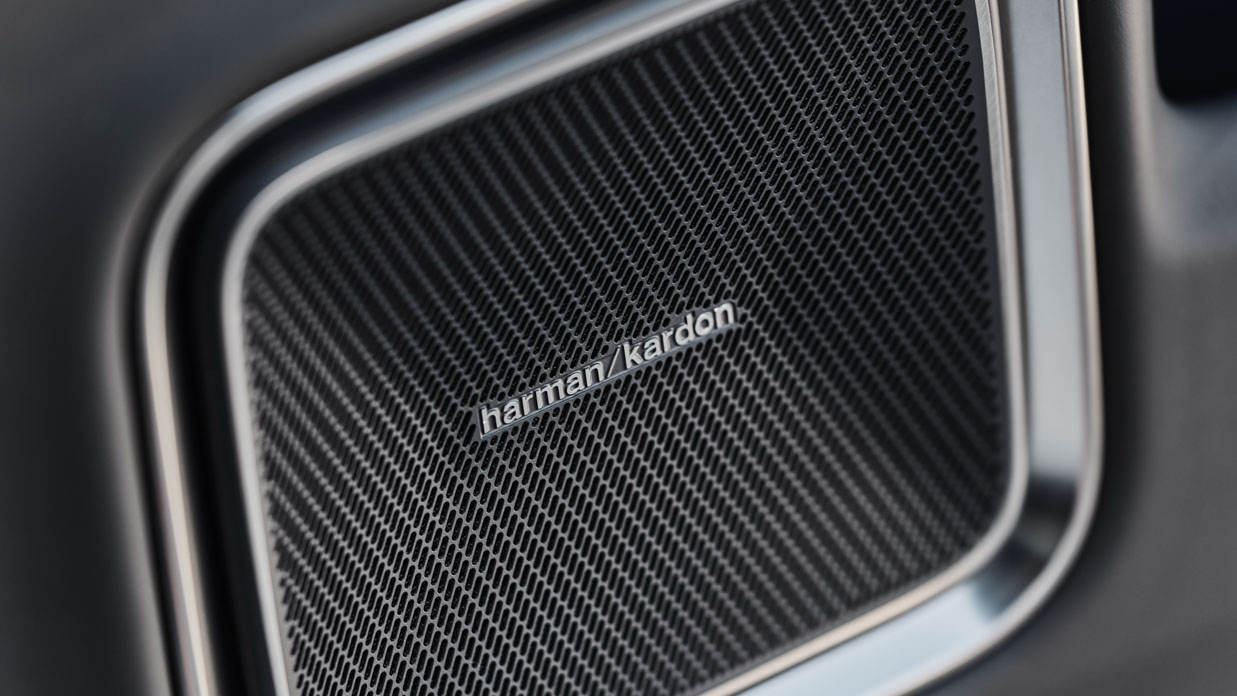
You’ll want the 3D knit or the Nappa because the base seat trim, charcoal vinyl, is pretty ordinary. Yet it is the only way you can get a Polestar 4 beneath the luxury car tax threshold; spend above LCT and fringe benefits tax can’t be waived. Nearly all EV sales in Australia are for cars priced beneath LCT.
The back seat is indeed generously-sized particularly when it comes to legroom – the near three-metre wheelbase will do that. But toe-room is constricted and headroom is only above average, nothing more, despite the vaunted deletion of the rear window.
There are small climate vents in the back, but far from the power of the main A/C, you notice the sun beating down through the standard-fit fixed glass roof. A $2700 premium buys an electrochromic dimming function, which engineers claim reduces glare but not heat. Meanwhile, $300 buys an old-school sunshade.
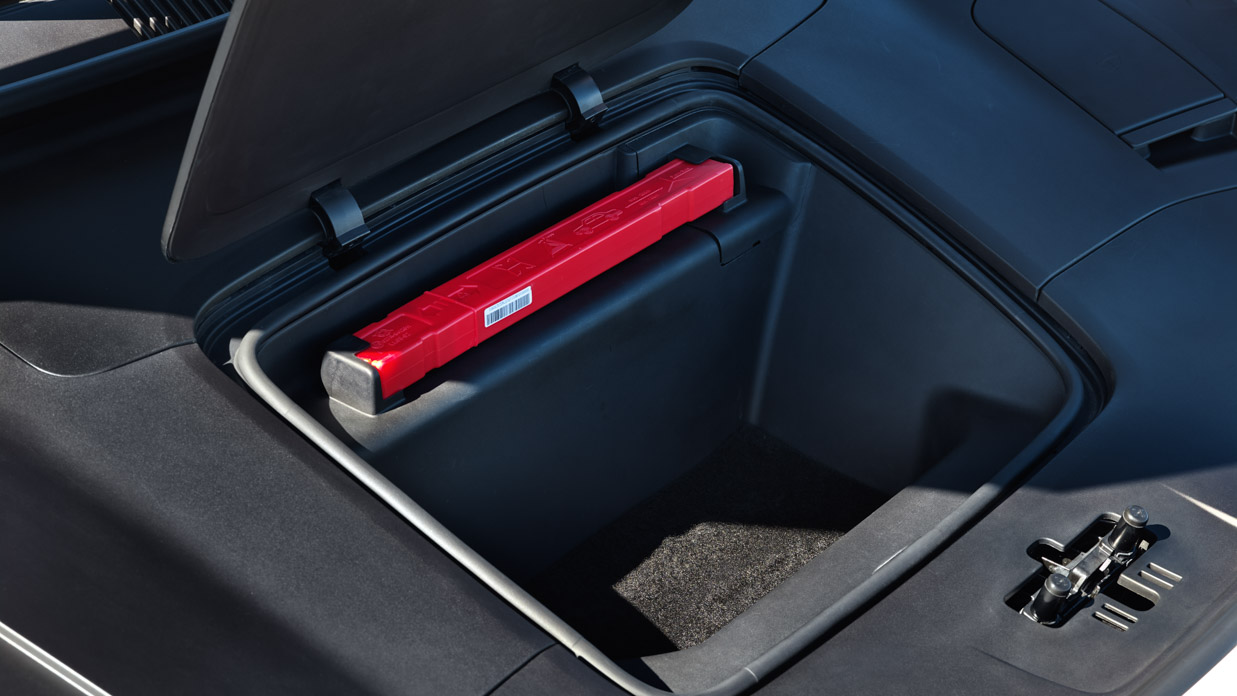
It’s an exhausting regression from traditional premium cars with an opening glass sunroof with a power-sliding blind, and a trend we think needs to come to a close.
Further back, the big hatchback door conceals a 526-litre boot with a small additional compartment beneath the floor, but some of the old touches shared with Volvo are gone now: there are no nifty grocery-bag holders as seen on the ‘2’ and ‘3’, for instance.
Up front a twin-pull bonnet latch allows the hood to be opened with one hand, revealing the sealed frunk, which is kind of useful but noticeably smaller than a Tesla Model Y: the Polestar 4’s 15 litres is played by the American car’s 117 litres.
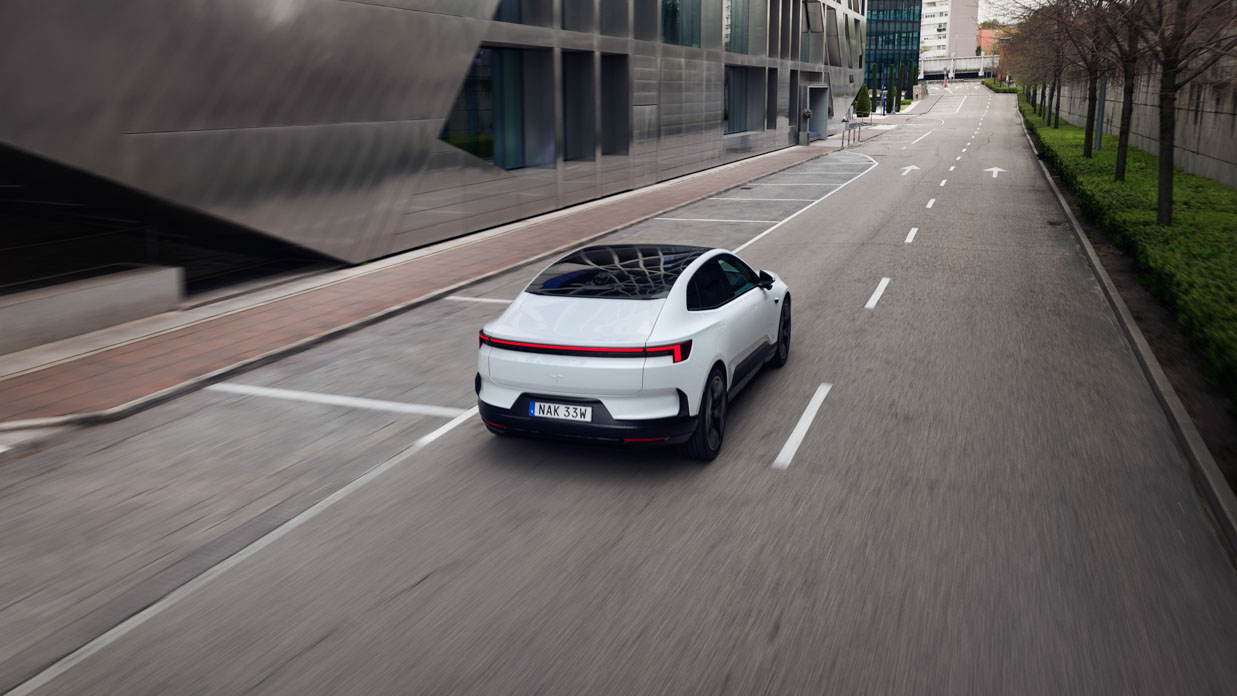
The Model Y Performance, which is priced a shade above an entry-level Polestar 4, can also charge more quickly, weighs hundreds of kilograms less, and has superior interior packaging. Like the ‘4’, the Model Y is pretty blunt to steer. And certainly, the Tesla is far less special to look at, or sit in.
But it is a timely reminder that, while Polestar itself claims to have moved beyond and above competing directly with Tesla (at least on price), there are many ways in which the EV market’s top-seller remains front-of-mind, including for some people that would consider a Polestar 4.
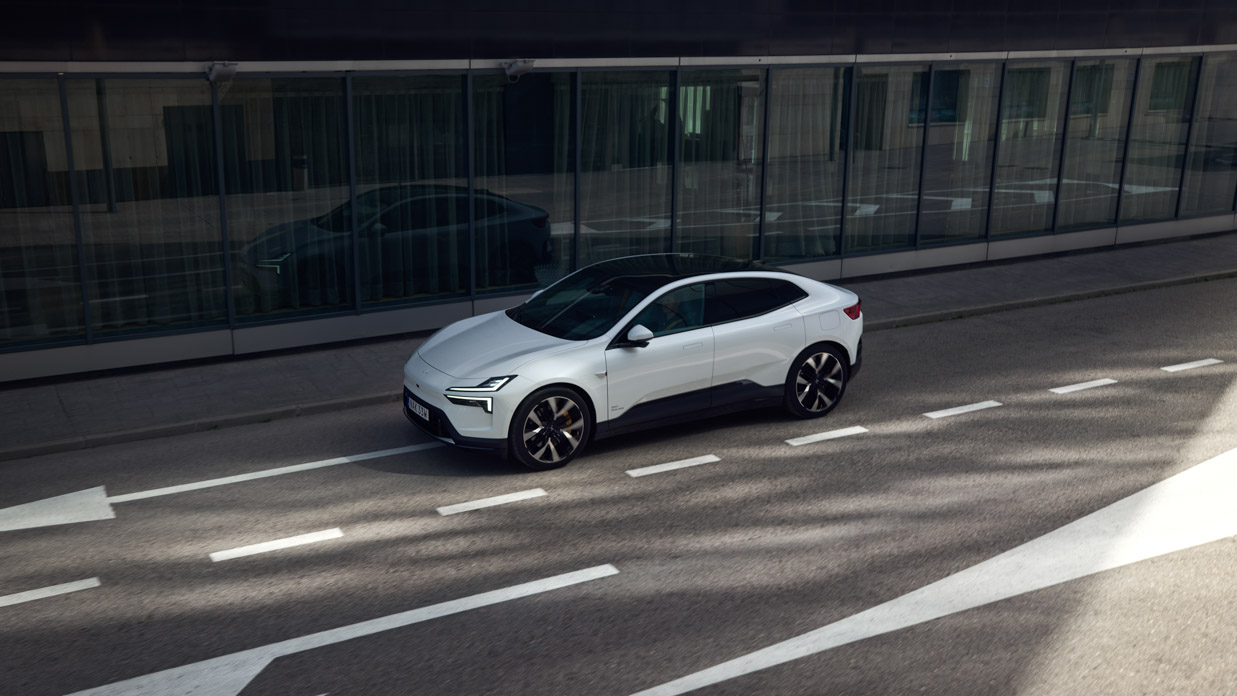
And for buyers that wouldn’t consider a Tesla – perhaps people who naturally gravitate to the Porsche Macan EV – the Polestar 4 needs to communicate why its dynamics are truly sporty and rewarding. Unlike the Polestar 3, the ‘4’ isn’t there yet. With the new Macan on the march, there is work to do.
[Editor’s note: Polestar Australia has subsequently explained to Chasing Cars that the Long Range Dual Motor with Performance Pack vehicles we tested in Madrid were “built to European specification” that will eventually be offered in Australia “with the exception of shock absorber and top mounts for these dampers, which were China-spec”.
“In all other aspects, including the tyres and software, the cars were EU spec. The reason for this was the availability of EU specific parts at the time of production. All customer cars built for non-China markets (such as Australia) will receive EU-specific hardware as planned.”]
About Chasing cars
Chasing Cars reviews are 100% independent.
Because we are powered by Budget Direct Insurance, we don’t receive advertising or sales revenue from car manufacturers.
We’re truly independent – giving you Australia’s best car reviews.
The estimate provided does not take into account your personal circumstances but is intended to give a general indication of the cost of insurance, in order to obtain a complete quote, please visit www.budgetdirect.com.au. Estimate includes 15%^ online discount.
^Conditions Apply
Budget Direct Insurance arranged by Auto & General Services Pty Ltd ACN 003 617 909(AGS) AFSL 241 411, for and on behalf of the insurer, Auto & General Insurance Company Limited(ABN 42 111 586 353, AFSL 285 571).Because we don’t know your financial needs, we can’t advise you if this insurance will suit you. You should consider your needs and the Product Disclosure Statement before making a decision to buy insurance. Terms and conditions apply.
Indicative quote based on assumptions including postcode , 40 year old male with no offences, licence suspensions or claims in the last 5 years, a NCD Rating 1 and no younger drivers listed. White car, driven up to 10,000kms a year, unfinanced, with no modifications, factory options and/or non-standard accessories, private use only and garaged at night.
^Online Discounts Terms & Conditions
1. Discounts apply to the premium paid for a new Budget Direct Gold Comprehensive Car Insurance, Third Party Property Only or Third Party Property, Fire & Theft Insurance policy initiated online on or after 29 March 2017. Discounts do not apply to optional Roadside Assistance.
2. Discounts do not apply to any renewal offer of insurance.
3. Discounts only apply to the insurance portion of the premium. Discounts are applied before government charges, taxes, levies and fees, including instalment processing fees (as applicable). The full extent of discounts may therefore be impacted.
4. We reserve the right to change the offer without notice.